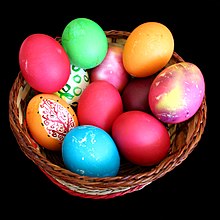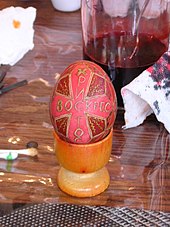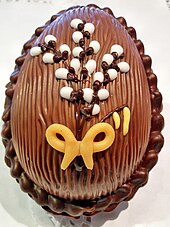부활절 달걀
부활절을 축하하기 위해 물감 등의 재료로 특별히 장식된 달걀
부활절 달걀(Osterei, œufs de Pâques, Easter eggs)[1]은 부활절을 축하하기 위해 특별히 장식된 달걀이다.



역사 편집
의식으로서 달걀 껍질을 꾸미는 관습은 고대부터 있었다.[2] 아프리카에서 발견된, 겉이 꾸며진 타조알은 60,000년 전이 된 것으로 추정된다.[3] 고대 북유럽 튜튼족이 숭배한 봄의 여신인 에오스트레(Eostre)를 기념하면서 튜튼족은 다산과 풍요를 상징하는 토끼와 달걀을 사용하였다. 이러한 풍습이 주변 이교도들에 전파되었고, 기독교가 유럽에 전파되면서 생명의 탄생, 재생의 의미를 부활과 결합하여 부활절에 부여하였다. 달걀을 서로 주고받는 행위가 널리 퍼진 것은 사순절의 금욕과 금식과도 연관이 있으며 부활절이 오기 전 예수 그리스도의 고난을 추모하기 위해 절제된 생활을 하기 위함이다.
부활절 달걀의 기독교 관습은 메소포타미아의 세미라미스 여신과 담무스에게서 시작되었다는 학계의 주장이 있으며, 이러한 이교도들 사이에서 시작된 풍습이 기독교와 결합되었다. 이들은 예수의 십자가형에 흘리신 그리스도의 피를 기억하고자 달걀을 빨간색으로 물들였다.[4][5][6][7][8]
각주 편집
- ↑ The Legend of Paschal Eggs (Holy Cross Antiochian Orthodox Church)
- ↑ Neil R. Grobman (1981). 《Wycinanki and pysanky: forms of religious and ethnic folk art from the Delaware Valley》. University of Pittsburgh. 2014년 4월 18일에 확인함.
During the spring cycle of festivals, ancient pre-Christian peoples used decorated eggs to welcome the sun and to help ensure the fertility of the fields, river ...
- ↑ “Egg Cetera #6: Hunting for the world’s oldest decorated eggs | University of Cambridge”. Cam.ac.uk. 2012년 4월 10일. 2013년 3월 31일에 확인함.
- ↑ Thompson, Kenneth (2013년 8월 21일). 《Culture & Progress: Early Sociology of Culture, Volume 8》 (영어). Routledge. 138쪽. ISBN 9781136479403.
In Mesopotamia children secured during the 40-day period following Easter day as many eggs as possible and dyed them red, "in memory of the blood of Christ shed at that time of his Crucifixion"--a rationalization. Dyed eggs were sold in the market, green and yellow being favorite colors. The use of eggs at Easter seems to have come from Persia into the Greek Christian Churches of Mesopotamia, thence to Russia and Siberia through the medium of Orthodox Christianity. From the Greek Church the custom was adopted by either the Roman Catholics or the Protestants and then spread through Europe.
- ↑ Williams, Victoria (2016년 11월 21일). 《Celebrating Life Customs around the World》 (영어). ABC-CLIO. 2쪽. ISBN 9781440836596.
The history of the Easter egg can be traced back to the time of the advent of Christianity in Mesopotamia (around the first to the third century), when people use to stain eggs red as a reminder of the blood spilled by Christ during the Crucifixion. In time, the Christian church in general adopted this custom with the eggs considered to be a symbol of both Christ's death and Resurrection. Moreover, in the earliest days of Christianity Easter eggs were considered symbolic of the thomb in which Jesus's corpse was laid after the Crucifixion for eggs, as a near universal symbol of fertility and life, were like Jesus's tomb, something from which new life came forth.
- ↑ Henry Ellis (1877). 《Popular antiquities of Great Britain》 (영어). 90쪽.
Hyde, in his Oriental Sports (1694), tells us one with eggs among the Christians of Mesopotamia on Easter Day and forty days afterwards, during which time their children buy themselves as many eggs as they can, stain them with a red colour in memory of the blood of Christ, shed as at that time of his crucifixion. Some tinge them with green and yellow.
- ↑ 《Donahoe's Magazine, Volume 5》. T.B. Noonan. 1881. 2012년 4월 7일에 확인함.
The early Christians of Mesopotamia had the custom of dyeing and decorating eggs at Easter. They were stained red, in memory of the blood of Christ, shed at His crucifixion. The Church adopted the custom, and regarded the eggs as the emblem of the resurrection, as is evinced by the benediction of Pope Paul V., about 1610, which reads thus: "Bless, O Lord! we beseech thee, this thy creature of eggs, that it may become a wholesome sustenance to thy faithful servants, eating it in thankfulness to thee on account of the resurrection of the Lord." Thus the custom has come down from ages lost in antiquity.)
- ↑ Vicki K. Black (2004년 7월 1일). 《Welcome to the Church Year: An Introduction to the Seasons of the Episcopal Church》. Church Publishing, Inc.
The Christians of this region in Mesopotamia were probably the first to connect the decorating of eggs with the feast of the resurrection of Christ, and by the Middle Ages this practice was so widespread that in some places Easter Day was called Egg Sunday. In parts of Europe, the eggs were dyed red and were then cracked together when people exchanged Easter greetings. Many congregations today continue to have Easter egg hunts for the children after services on Easter Day.
| 이 글은 역사에 관한 토막글입니다. 여러분의 지식으로 알차게 문서를 완성해 갑시다. |